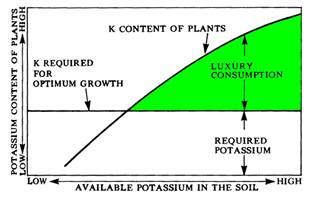Everyone that grows forages knows of the importance of potassium for top alfalfa production. Next to nitrogen, it is the next most highly required element by the growing plant. For every 1 ton of dry matter production, alfalfa contains 55-70 lbs of K2O. This means that at 6 ton/acre the crop is removing 330-420 lbs K2O/acre (or 600-700 lbs of 0-0-60). If sufficient amounts of fertilizer are not applied, the crop will absorb these nutrients from the soil and lower the potassium level in the soil.
Critical for photosynthesis
Critical for the production, storage, and transfer of plant foods made in the leaves, to other parts of the plant
Critical for N fixation by legumes
Critical for water-use efficiency
Critical for the production of plant protein
There are three forms of K in the soil:
Soluble K is the smallest portion of the total soil K. By supplying current plant needs, annual applications of K minimize losses of this element.
Exchangeable K is held on the soil colloids and is readily available to plants. This fraction also makes up a small percentage of the total K in the soil.
Non exchangeable K is held within the clay fraction of the soil and is neither soluble nor available to plants. Non exchangeable K makes up the largest portion of total K in the soil, except in highly acid, sandy soils or on soils that are high in organic matter, where non exchangeable K levels are relatively low. As soil minerals weather, non exchangeable K gradually becomes available.

Sometimes, when soil potassium levels are high, plants may take up more potassium than is needed for maximum yield. This “luxury consumption” (see figure) by alfalfa and forage grasses can lead to high levels of potassium in the forage part of the ration. It is important to remember that this luxury consumption is not only influenced by soil potassium levels but also the soil test level of the other cation elements as well as soil moisture and growing conditions.
In the March 2003 issue of Hay and Forage, there is an article that addressed some ways to lower potassium levels in forages:
Plant a grass companion crop and apply moderate to high rates of nitrogen. This will force the plants to use more soil-based potassium, thus reducing the amount available for future harvest.
Increasing the number of cuttings of either alfalfa or grass will also stimulate K uptake.
To minimize the amount of K in alfalfa, cut the crop close to the ground. The highest potassium concentrations are in the upper stems.
K level will also drop as the alfalfa matures. In one study, it declined from 2.75% to 1.75% from late vegetative stage to one-fourth bloom.
Once the hay is lying in a windrow, K levels can significantly be reduced by rain and leaching. Recent research showed that 0.6 inches of rain reduce tissue K from 2.5% to 1.9%.
These are a few suggestions that can help to manage potassium levels in alfalfa. The easiest way to lower potassium in dairy diets might be to adjust the feed ration, in this way the grower can still achieve maximum yield as well as quality of the forages.
